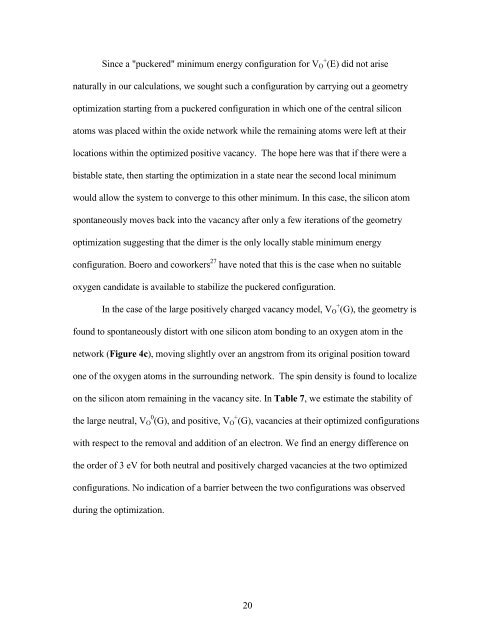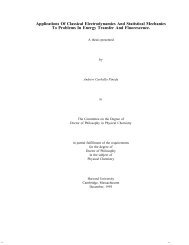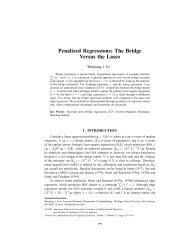Electronic Structure Theory of Radiation-Induced Defects in Si/SiO2
Electronic Structure Theory of Radiation-Induced Defects in Si/SiO2
Electronic Structure Theory of Radiation-Induced Defects in Si/SiO2
Create successful ePaper yourself
Turn your PDF publications into a flip-book with our unique Google optimized e-Paper software.
S<strong>in</strong>ce a "puckered" m<strong>in</strong>imum energy configuration for V + O (E) did not arise<br />
naturally <strong>in</strong> our calculations, we sought such a configuration by carry<strong>in</strong>g out a geometry<br />
optimization start<strong>in</strong>g from a puckered configuration <strong>in</strong> which one <strong>of</strong> the central silicon<br />
atoms was placed with<strong>in</strong> the oxide network while the rema<strong>in</strong><strong>in</strong>g atoms were left at their<br />
locations with<strong>in</strong> the optimized positive vacancy. The hope here was that if there were a<br />
bistable state, then start<strong>in</strong>g the optimization <strong>in</strong> a state near the second local m<strong>in</strong>imum<br />
would allow the system to converge to this other m<strong>in</strong>imum. In this case, the silicon atom<br />
spontaneously moves back <strong>in</strong>to the vacancy after only a few iterations <strong>of</strong> the geometry<br />
optimization suggest<strong>in</strong>g that the dimer is the only locally stable m<strong>in</strong>imum energy<br />
configuration. Boero and coworkers 27 have noted that this is the case when no suitable<br />
oxygen candidate is available to stabilize the puckered configuration.<br />
In the case <strong>of</strong> the large positively charged vacancy model, V + O (G), the geometry is<br />
found to spontaneously distort with one silicon atom bond<strong>in</strong>g to an oxygen atom <strong>in</strong> the<br />
network (Figure 4c), mov<strong>in</strong>g slightly over an angstrom from its orig<strong>in</strong>al position toward<br />
one <strong>of</strong> the oxygen atoms <strong>in</strong> the surround<strong>in</strong>g network. The sp<strong>in</strong> density is found to localize<br />
on the silicon atom rema<strong>in</strong><strong>in</strong>g <strong>in</strong> the vacancy site. In Table 7, we estimate the stability <strong>of</strong><br />
the large neutral, V 0 O (G), and positive, V + O (G), vacancies at their optimized configurations<br />
with respect to the removal and addition <strong>of</strong> an electron. We f<strong>in</strong>d an energy difference on<br />
the order <strong>of</strong> 3 eV for both neutral and positively charged vacancies at the two optimized<br />
configurations. No <strong>in</strong>dication <strong>of</strong> a barrier between the two configurations was observed<br />
dur<strong>in</strong>g the optimization.<br />
20













